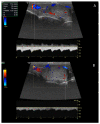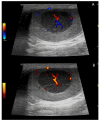Ultrasound-Based Technologies for the Evaluation of Testicles in the Dog: Keystones and Breakthroughs
- PMID: 38133235
- PMCID: PMC10747277
- DOI: 10.3390/vetsci10120683
Ultrasound-Based Technologies for the Evaluation of Testicles in the Dog: Keystones and Breakthroughs
Abstract
Ultrasonography is a valuable diagnostic tool extensively used in the andrology of human and domestic animals, including dogs. This review aims to provide an overview of various technologies based on ultrasound, from the basic B-Mode ultrasonography to the more recent advancements, such as contrast-enhanced ultrasonography (CEUS) and ultrasound elastography (UEl), all of which are utilized in the evaluation of canine testicles. The review outlines the principles behind each of these technologies and discusses their application in assessing normal and abnormal testicular conditions. B-mode canine testicular ultrasonography primarily focuses on detecting focal lesions but has limitations in terms of objectivity. Other technologies, including Doppler ultrasonography, B-Flow, and CEUS, allow for the characterization of vascular patterns, which could be further measured using specific applications like spectral Doppler or quantitative CEUS. Additionally, ultrasound elastography enables the assessment of parenchyma stiffness both qualitatively and quantitatively. These ultrasound-based technologies play a crucial role in andrology by providing valuable information for evaluating testicular function and integrity, aiding in the identification of pathological conditions that may impact the health and quality of life of male dogs.
Keywords: B-flow; CEUS; dog; doppler; sonoelastography; testis; ultrasonography.
Conflict of interest statement
The authors declare no conflict of interest.
Figures











References
Publication types
LinkOut - more resources
Full Text Sources

